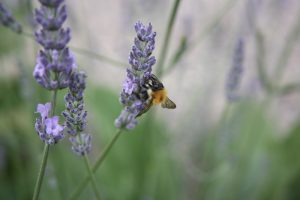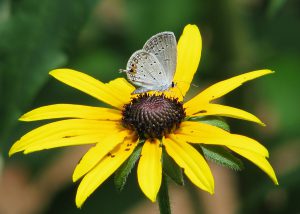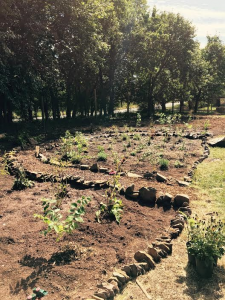Wildlife returns to the industrial Newark Bay waterfront
by David Wheeler
Under the sweltering September sun, our team discovers the earth at our fingertips. We ready the manure, topsoil, and mulch, wield the pickax and trowel, and labor the wheelbarrow through the trees and up the slope of a tidal berm.
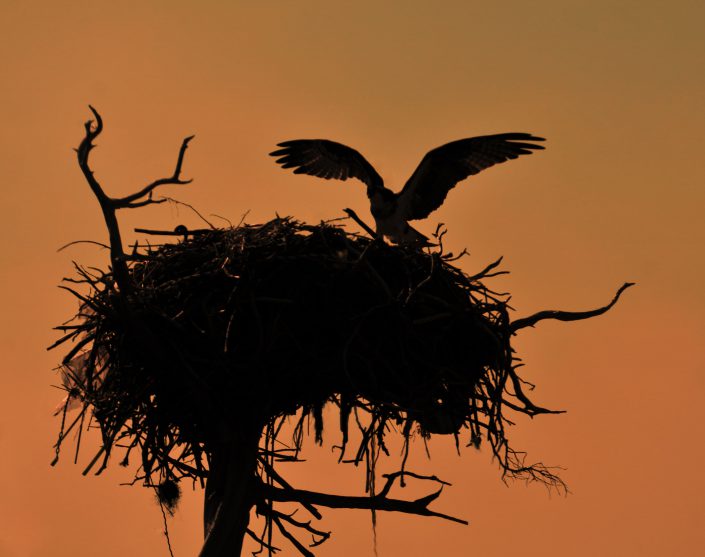
We plant 250 native shrubs and 580 native herbaceous plugs. We hammer in nest boxes, install pollinator houses, construct mounds of brush for local and migrating wildlife, and create nesting habitat for northern diamondback terrapin, an at-risk turtle species.
We lose ourselves in nature for the day.
A migrating butterfly flits past leisurely and I look up from the soil to wipe my brow. Suddenly I remember exactly where this newly vibrant natural ecosystem is. Nearly overhead, I can watch never-ending streams of commuters and tractor trailers motor past over one of the busiest bridges in the nation – the Newark Bay Bridge. Just across the bay, I can see heavy industry. Out beyond the fence, more industry – ancient, tireless, modern progress marching forward.
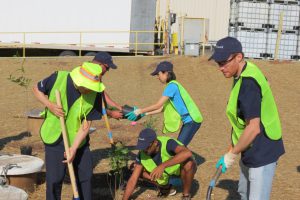
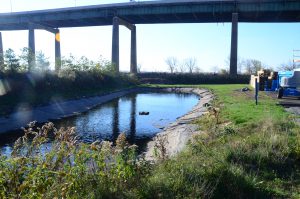
Yet on this morning, and those that follow, we now have ecological progress here as well, in a place that was written off entirely not so long ago. The Newark Bay region has suffered a century and a half of environmental degradation at the hands of industry and unbridled development.
This active industrial site is home to Firmenich Inc., one of the largest manufactures of fragrances in the world. We have transformed the land today to invite wildlife partners to help balance the scales of the region’s damaged ecology.

These partners are vital to our environment, to our health, to the world around us. They are the butterflies and bees, the wasps and beetles, the flies and moths that make up an army of pollinators that in coordinated effort provide humanity with the lungs of our planet. Without these pollinators, native plants could not sink carbon dioxide and impart oxygen to our surroundings, every minute of every day. Without these pollinators, the bread baskets of the world would wither away, no longer filled with grains, fruits, and vegetables.
The natural partnerships don’t stop with the pollinators born forth from meadow creation. These partners extend to migrating songbirds and mighty raptors, small mammals and diamondback terrapins.
“If we give nature an inch, it’s going to take a yard. Give it a chance and nature will return,” says biologist Blaine Rothauser, who is directing the restoration for GZA Environmental. “Wildlife just needs an opportunity.”
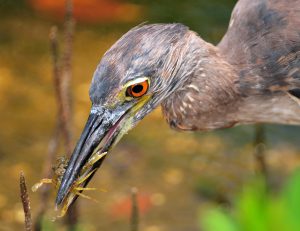
Nature’s inspiring return builds upon decades of ecological recovery in the region. Thanks to President Nixon’s Clean Water Act of 1973, the water began to get cleaner. Improving the water quality reanimated the food chain from the bottom up – phyto- and zooplankton, invertebrates and crustaceans reappeared. In turn, a fishery was reborn, which ushered in the return of herons, ibis, osprey, turtles, and even harbor seals – seen sunning on the banks of tidal shores in winter!
Yet much of the land around the water’s edge is still wanting.
“The restoration site is an important buffer habitat to a large portion of undeveloped tidal bay directly adjacent to the Firmenich complex,” says Rothauser. “Today we have 60 people planting a native community of shrubs, trees and plants on a formerly sterile lawn and an unnaturalized earthen berm. It is vital work that makes a real difference.”
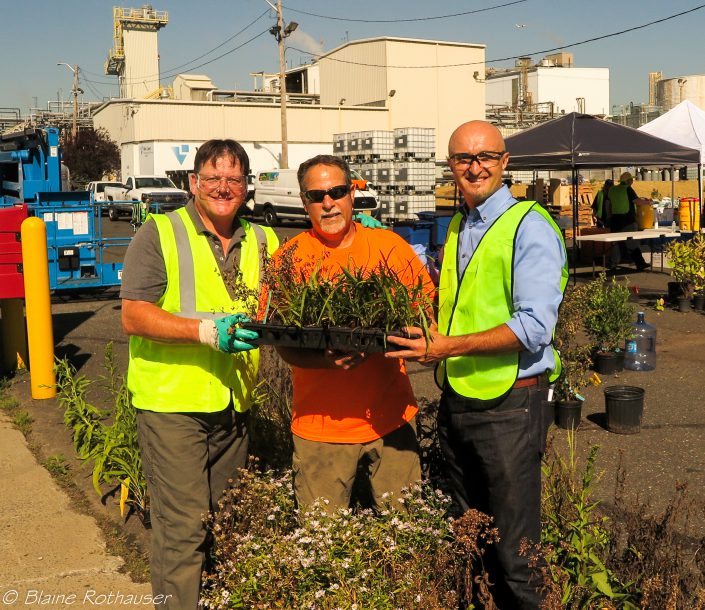
The team has also created opportunities for rare species to nest. Above our heads, an osprey platform has been installed, empowering this magnificent fish-eating raptor to continue its recovery along Newark Bay and many other New Jersey waterways, industrial and remote alike.
A barn owl box offers one of our most mysterious nighttime predators the opportunity to set up shop in a beneficial area – where there is no shortage of rabbits and field mice to help control.
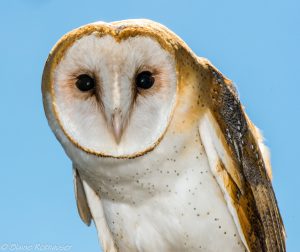
Across the pond, a purple martin condominium-like house offers the ample space necessary for these communal swallows to reside, a home base where they can feast on flying insects.
With the first phase of the project almost complete, the second phase will seek to transform the site’s holding ponds into ecologically productive floating wetlands, bringing herons and egrets and other wading birds.
Ultimately, this project is envisioned as one that can be replicated just about anywhere along Newark Bay – or any industrial waterfront for that matter. All it takes is the willingness to look at a site’s land from a different perspective – and in so doing, to understand that the ecological benefits of bringing back many wildlife species aren’t negated by losing economic tradeoffs.
Instead they can mean parallel economic benefits. Natural pest control. Fewer landscaping and pesticide costs. Increased employee morale and productivity, with a newfound opportunity to recharge body and mind with a rejuvenating break outside, enjoying natural beauty and the engagement of your senses.
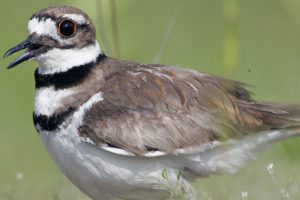

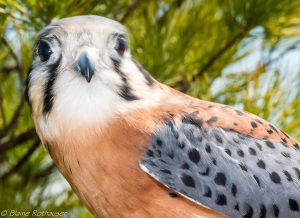
Images above from left to right – Killdeer, 12 Spotted Skipper, and American Kestrel.
New Jersey has long served as a primary engine for America’s industry and commerce – and in return has often been derided as the “Which exit?” land of nothing but turnpike and smokestacks. The Meadowlands just to the north of here bore the brunt of that reputation, yet in recent decades has made a mind-blowing ecological recovery to become a wildlife – and ecotourism – destination.
The waters flow south from the Meadowlands along the Hackensack and Passaic Rivers, and they come together in the Newark Bay. Now, that next wave of wildlife recovery and habitat restoration has arrived just downstream – along the Newark Bay waterfront.
For wildlife, it’s where the action is.
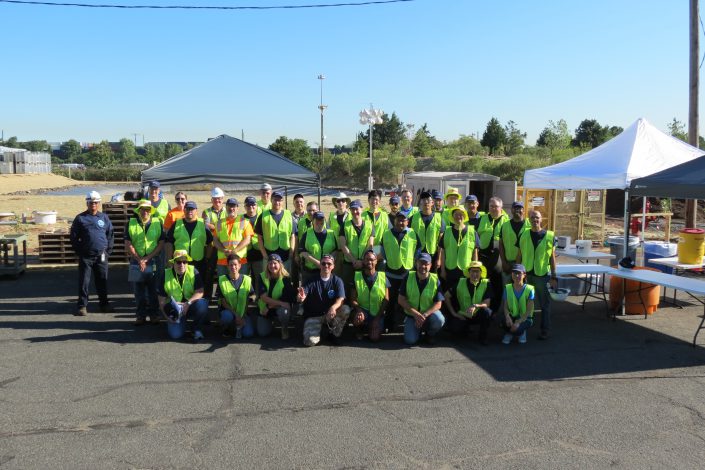
David Wheeler is the executive director of Conserve Wildlife Foundation and author of the book, Wild New Jersey: Nature Adventures in the Garden State.
All photos courtesy of Blaine Rothauser.
